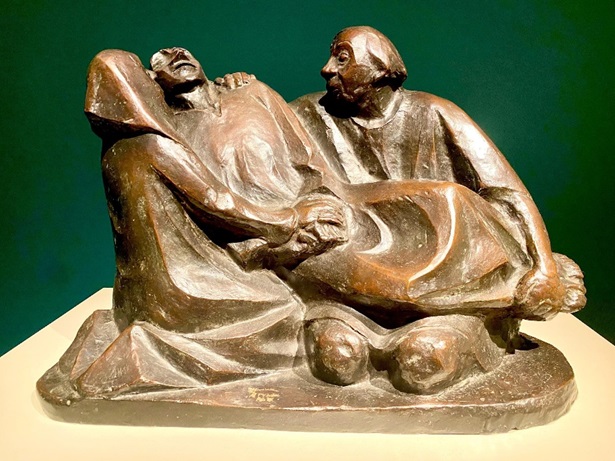
Ernst Barlach
German, 1870-1938
Der Tod (Pieta), 1925 modelled; post-1938 cast
bronze
12 1/2 x 18 1/2 x 9 1/4 in.
SBMA, Gift of Mrs. Rowe Giesen
1991.87.2

Ernst Barlach Photo by Karl Heinz Wulf
“He, who is gripped by art is not released, it can’t be helped. My work represents the externalization of an inner process.” - Ernst Barlach
RESEARCH PAPER
The work “Pieta” (“Pity”) by Barlach, also known as “Der Tod,” (“The Death”) 1925, is a group sculpture showing a dying man and two kneeling figures, a man and a woman. The figures resonate with sadness and loss. Although this sculpture is a later bronze (1938) it is as concentrated and powerful as his wood sculptures, yet more moving and concise.
The most striking aspect of the figures is their strong contrasts. On the one hand, there is the motionless, symmetric, solid massiveness, and on the other hand the dramatic outline. This closeness to the earth, the earthbound heaviness, is the one pole to which all of Barlach’s sculptures are related.
This belonging to two worlds, the suffering, despairing and hopeful, the lonely and the waiting, the driven and the persecuted, the overwhelmed and obsessed, are all present in his works. All of Barlach’s works share a basic emotion, whether their theme is the Russian steppes or an imaginary landscape. The awareness is there that man is made of clay and will return to earth. Many of his works undoubtedly had religious roots. He did not adhere to a specific religious belief, but he did want to assert a universal faith.
Ernst Heinrich Barlach was born in Wedel, Holstein, Germany on January 2, 1870, and died on October 24, 1938, in Rostock. He was a German Expressionist sculptor, medalist, printmaker, and writer. In addition to his sculptures, Barlach wrote eight Expressionist dramas, two novels, and an autobiography, “Ein Selbsterzahltes Leben” He also had a distinguished oeuvre of woodcuts, lithographs, and illustrations.
He spent his childhood in Schonberg, Mecklenburg, where his father practiced medicine. Due to his artistic talent, he studied at the Royal Art School, Dresden. He continued his studies in Paris at the Academie Julian and also spent a year in Florence, Italy. He remained critical of the German tendency to copy the style of French artists. He was famed for his sculptures of religious and mystical figures, anti-war sculptures, and many of Russian peasants.
In 1906 he traveled to Russia to visit his brother Hans. This trip to Russia was one of the greatest influences on his style and a turning point in his artistic development. He felt more related to the mystic soul of the Russian peasant than to Western nationalism and Roman Catholicism.
The formative experience in Russia helped him develop his style, focusing on the faces and hands of the people in his sculptures and reducing the other parts of the sculptures to a minimum. He began to make wood carvings and bronzes of figures swathed in heavy drapery like those in early Gothic art.
After he returned from Russia, Barlach’s financial situation improved considerably, because Paul Cassirer, an art dealer, now represented him. In 1917, in the middle of World War 1, Cassirer opened Barlach’s first big exhibition in Berlin.
The problem with Barlach’s art during the rise of the Nazi party was its apolitical stance to Fascism. Instead, it harbored an emotionalism, individualism, and sense of mourning, which was difficult to integrate into the victorious nature of Nazi art. The horror of war shocked him, and he returned as a pacifist and opponent of war.
From 1928 Barlach generated many anti-war sculptures that went against the political trend during the rise of The Third Reich. The Nazis, especially Joseph Goebbels, who was the Minister of Propaganda, were angered by his anti-war message. In 1936, during an exhibition, 381 of Barlach’s works were confiscated, dismantled, or melted down. The work was described as ”degenerate” art, un-German, and “destructive modernism.”
Barlach was prohibited from working as a sculptor, and his membership in the art academies was canceled. As a result of Nazi propaganda, Barlach was shunned by his fellow townspeople and was condemned as a Bolshevik Jew and “an alien,” which was not true.
This rejection by the art world is reflected in his final works before his death from heart failure on October 24, 1938, in Rostock, Mecklenburg.
Prepared for the Santa Barbara Museum of Art Docent Council by Thea Van Tonder, 2024.
BIBLIOGRAPHY
Barlach Haus, Ernest,
https://www.barlach-haus.de/en/musum/collection.
Carls, Carl Dietrich, “Barlach,” p 81, 90
Jansen, Elmar, “Ernst Barlach”, p 14.
Henry, Jennifer, “Whatever happened to Ernst Barlach.”
Nielsen, Kristen, ”German Political Monuments and the Art of Resistance” Princeton University Art Museum.
https://artmuseum.princeton.edu
SBMA CURATORIAL LABELS
Sculptor, printmaker, and playwright, by the time Barlach conceived of this Pietà, he was a well established artist. Beginning in 1907, he joined the stable of artists supported by the influential Paul Cassirer, who gave him his first major exhibition at his gallery in 1917. After serving the three-month minimum as an infantryman during World War I, Barlach became a staunch pacifist, which put him at odds with the political climate, especially during the years leading up to the rise of the Third Reich.
This is a late cast of a sculpture that Barlach first modeled in 1925. It displays the simplification of form, with a concentration on the expressive face and hands, for which Barlach was known. Although Barlach received several important state commissions for such religious subjects in the 1930s, in 1937 his art was confiscated and included in the Degenerate Art exhibition staged by the Nazis. He died a year later.
- Ridley-Tree Reinstallation, 2022
